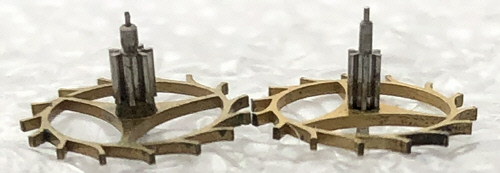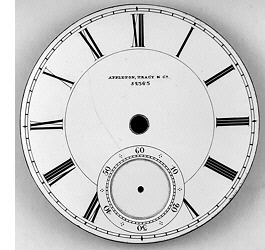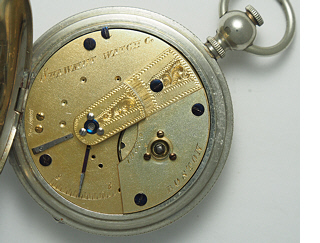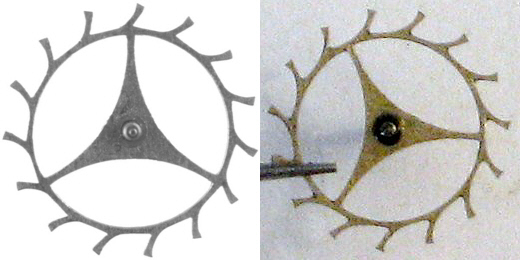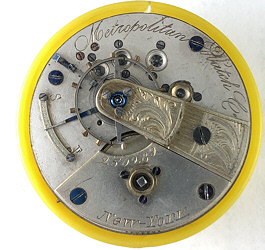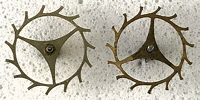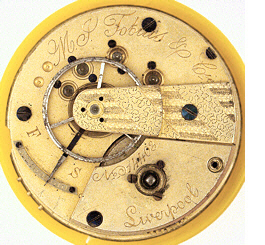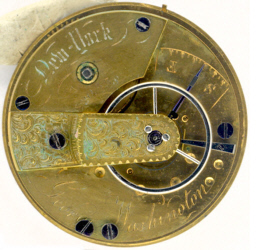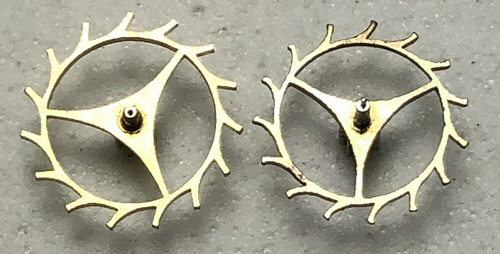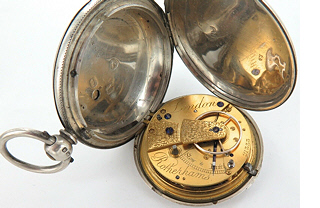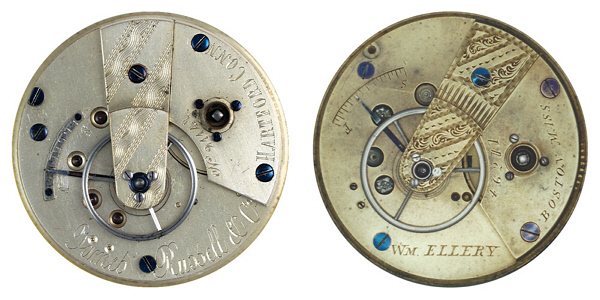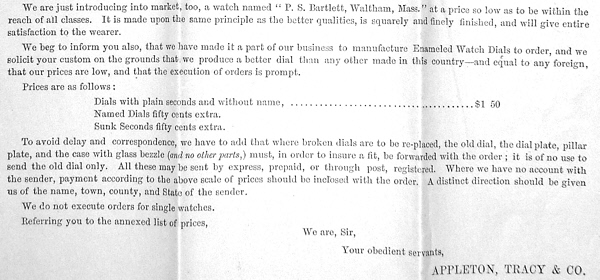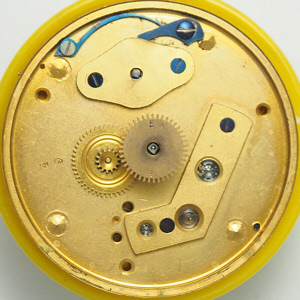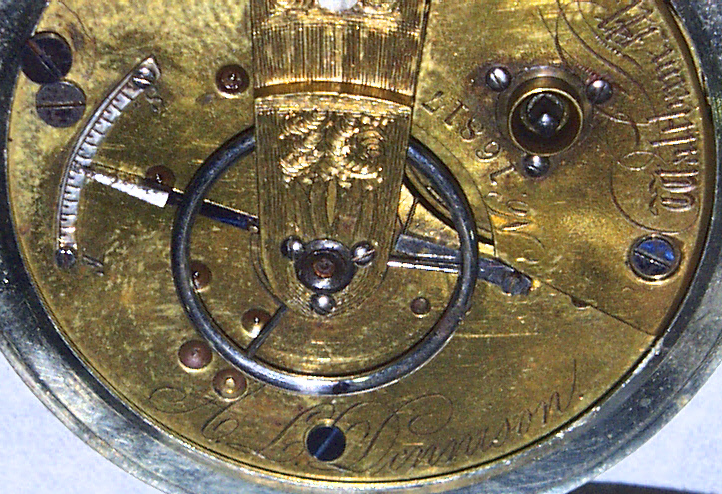|
http://www.plads.com/m57/JamesRussell/ James Russell Pocket Watches by Chris Carey (MA) and narrated by Ron Price (SC) with technical support from Michael Edidin (MD)
Have you seen a James Russell pocket watch that appears to be an early custom or private label American Watch Co Model 57, and wondered what it was? So do I. Although each movement has something inconsistent with a M57, everything else looks correct. Indeed, the James Russell looks like some watchmaker made it from M57 parts, including in particular critical top and bottom plates. Even James Russell dials are surfacing separate from James Russell movements. I first encountered a James Russell watch on February 4,1996, when William Meggars FAXed me data sheet information on it (#20493) for my monograph Origins of the Waltham Model 57 under the custom category. Next was a January 11, 2001 eBay ad for JR #20687. Several more soon followed. The M57 private-label/custom category was a mistake as I have since learned. Early on in my research, fellow researcher Michael Edidin sent me his James Russell #20145 for hands on examination (shown above, click for larger view). In my hand I would have sworn it was a Waltham M57 until I measured some parts. Although close, they were not exactly the same as Waltham parts. A great copy! Or was the movement remanufactured? And why? Chris Carey arranged JR presentations with me catching tomatoes at NAWCC Ch. 8 in February 2007 and at Greater Boston W&C Collectors in March 2013. It turned out we were not the only ones wondering who made James Russell pocket watches. The JR mystery was on. Many collectors say these James Russells are just Swiss fakes. In fact this statement was made in a NAWCC Bulletin as far back as 1960 (#87, page 275). Amazingly these old timers were good observers without the treasure of documentation we have today. However, the James Russell watch is not like any Swiss (or English) fake I've seen. At least around 2013 I never saw a fake with plates essentially interchangeable with Waltham M57 factory plates (my view changed by 2020 - see below toward end of article where several excellent Swiss copies are described). However, the JR is a much better copy (lookalike) with complete sub-assembly numbering of its parts.
Hundreds of movements were made. Clearly this was not an extemporaneous activity. Indeed, contributor Jeff Marcus (NY), who has seen and restored more JRs than anybody, advocates recognizing James Russell & Co much like Tremont Watch Company and Philadelphia Watch Company. Adding my perspective, any enterprise, foreign or American, that had the technological ability in 1860 to replicate two M57 grades in large numbers with equivalent tight tolerances and interchangeable parts had to be quite unique; I want to know who they were and why they wanted to replicate Waltham watches. I originally thought perhaps James Russell movements were made in England in the 1860s and maybe finished here from different ebauches and parts. However, the train speed is the Model 57 speed of 16,200 beats per hour, not the earlier English speed of 14,400. Our English friends (e.g., Philip Priestley and David Penney ) think they are American built or with American machinery. Nearly half of the James Russells listed here look very much like an early (e.g., circa 1859) AT&Co grade Model 57 and most have dials with Arabic numerals in a serpentine script (the pictures above are for James Russell #20145). The dials on #20716, #20788 and #24281 have Roman numerals, but note the signatures on all of the dials are in a straight line. Shown here is #20716 (click for larger view). All of the other James Russell movements listed here have a hidden stud for the hairspring under the balance bridge. That is, they look like an 1859 P.S. Bartlett M57 grade, and their dials have Roman numerals with the signature in a curve (e.g., #21147). Shown here is #21147 (click for larger view). The JR signature on the movements like #20145 (above top) and #20716 is in block letters facing the center (i.e., like AT&Co grade) whereas the signature on the movements like #21147 is in script facing the edge (i.e., like PSB grade). The James Russell watchmaker clearly produced two distinctive grades of watches with characteristic dials. Where jewel count is known, all higher grade movements listed here are 15J whereas all lower grade movements are either 7J or 11J. With an approximate 10% survival rate as seen with Boston Watch Company watches, the James Russell watches listed here represent a sizable production of watches. This was a sizable business for a watchmaker in the 1860s!
When the Boston Watch Company went insolvent, on February 2, 1857, an inventory was taken of the contents of the factory. Fortunately for us, this inventory was written in a detailed document which was submitted in an insolvency court case. The document survived in court archives. [Origins: refs-notes, case 116, sheet 153]. Here is image of the first page.
The inventory consisted of a vast amount of watch parts, around 100 partial movements and 1,170 frames. Frames were partially finished pairs of plates apparently already stamped with serial numbers. The term “frames” must have included their attached parts like pillars, barrel bridge, balance bridge, potance and third-wheel (long) bridge because these parts were not otherwise listed in the parts inventory. This explains finding fully completed frames in JR movements with their attached parts appropriately stamped with corresponding sub-numbers. To facilitate reading the insolvency documents, Richard Watkins transcribed them [Watkins; Appendix 1]. Here is copy of Richard's transcribed inventory. My theory is that the Waltham factory was selling "seconds" (i.e., rejected parts that didn't meet their specifications) and someone was re-fitting them to make James Russells as a business. The factory was adamant about interchangeability and they likely had many rejects in the 1860 period before advanced automatic machinery came into play. Contributor Jon Weber points out the parts might not be so-called "seconds", but rather test runs or obsolete parts. He also points out that the plates, particularly the pillar plate, are the foundation of the movement. To be exactly the same, they would have had to come from the factory or replicated with similar massive equipment. There is a lot of circumstantial evidence indicating that James Russell was an 1860s watch, maybe even beginning in 1858 or 1859. In particular, Mike Warren's JR #20242 was carried through out the civil war by a soldier who mustered in on August 28, 1862 (actually the watch box is so marked, not the watch itself). The case on Dave Wallace's JR #331 is engraved '62 (1862 ?). The dial on JR #733 looks like an 1860s dial (shown below).
There is more evidence of a Waltham connection. The dials on most of the higher grade James Russell movements listed here (about half of the above listing) have the same Arabic style numerals as dials on early Waltham AT&Co grade M57s possibly painted by Josiah Moorhouse; e.g., #6375 (Nov 1858) shown here, #6429 (Dec 1858), #6690 (Jan 1859), #6716 (Dec 1858), #15590 (Jan 1859), #16594 (Apr 1859), #17939 (Jul 1859) and #22070 ('59&'60). Additional examples exist on hidden stud P.S.Bartlett movements; e.g., #14182 (11-12 '58 except seconds is not sunk), #17311 (Mar 1859) and #20232 (May 1859). There is also a similar style dial on a private label watch, N.S. Daniels (probably around early 1860) but with the dial signed American Watch Co.! Also AT&Co M57 19194 (Sept 1859) has a James Russell dial, although it could be a replacement. Contributor Vahram Erdekian believes these dials were not made by Moorhouse. They do have Arabic numerals in a serpentine script style, but they do not have most of the other characteristics of a Moorhouse dial. For example, the proportions of the Arabic numerals are very poor, and the numerals do not have the Moorhouse "tails". Moorhouse was known for his highly embellished dials in later life; perhaps he employed a simpler style with his earlier work. According to Clint Geller (see article on E. Howard dials, NAWCC Bulletin #285, Aug. 1993, page 402), Moorhouse was only 21 when he hired on with Appleton, Tracy & Company on August 3, 1858, after immigrating from England in 1854. This seems a little young to be starting out painting fancy Arabic dials on movements by November 1858 per the above example (AT&Co #6375). Maybe Moorhouse did later after being coached by someone who could paint such dials, but he could not have painted all of the example dials listed here, in particular the James Russell dials, because he was at Nashua Watch Company, Circa 1859-1862.
Ken also noted that the numerals on the later AT&Co dials (1859/60) and on the James Russell dials are elongated more than on the 1858 AT&Co dials. Was this a progression of style or a result of different artists? I think it was just a coincidence, depending on the movement. Samuel Curtis, reported nephew of clockmaker Aaron Willard, Sr. ([Origins: ref. 6, p274 and ref. 51, p11]), was a renowned clock dial maker with a business in Boston. Samuel painted similar Arabic dials, but much earlier than 1858. Many clocks are known to have his label affixed to the back of their dials, Curtis Manufactory. See Willard's Patent Time Pieces by Paul Foley, 2002, page 237. Shown below left is dial on Patton & Jones, Philadelphia, Circa 1815 (click for clock view). The dial on a similar clock from Larson's Antique Clock Shop, Lot 8068 is a little clearer. The numerals are Arabic, but also notice the stylishness flair. Although Arabic numerals are easier to read, most antique clock dials have Roman numerals. Maybe it was a popularity matter for the 1800s, but I read somewhere Arabic dials are much more difficult to paint. I would think serpentine script numerals would be even more difficult. I have found three clock dials with serpentine script numerals; two are in Foley pages 82 & 153. Shown above right is Jonathan Billings, Acton, MA, striking banjo clock, with heavy iron Arabic dial, Circa 1825 (10 years later). Click for clock view . Samuel Curtis was born in Roxbury, MA, October 17, 1785. He painted clock dials on metal, manufactured them and became very successful selling clock dials and mirrors. He even operated an 1840s iron foundry in Boston. He financed the BWCo initially but lost his wealth when the company went insolvent. I questioned if he could have painted JR dials in retirement after the insolvency. Michael Edidin conducted a search of Boston newspapers around 1858-1863, and found nothing that would connect Samuel Curtis with dial making, nor with James Russell. Responding to this subject, Robert Cheney, Executive Director and Curator of the Willard House & Clock Museum, "It is highly unlikely that the same Samuel Curtis who painted clock dials, switched gears and painted watch dials. These are really two distinct trades and one trained for one, is unlikely to work another". Edidin's comment, "Thinking about the wavy Arabic numerals on watch and clock dials, I've come to the conclusion that the style was not unique to one painter, but rather was a pattern book style used by many." So, Mr. Curtis is not our guy. However, the point is, the maker of James Russell watches wanted to embellish many of the high grade movements with a fancy dial painted with difficult Arabic numerals in a serpentine script style. Everybody asks, who was James Russell? Mary Jane Dapkus, when Secretary of NAWCC CT Chapter 148, researched documents looking for a James Russell watchmaker, jeweler, watch importer, company in Hartford CT in the 1860s/70s. She found none (and Mary Jane is an expert at genealogy). Ditto Michael Edidin's investigations. Therefore, the signature on the James Russell watches was very likely a made-up, good-sounding name, although it could be for a real person. As Mary Jane found, there were two prominent James Russells in the Hartford area in the 1860s (James L., a soldier 8th CT Regiment, and James N., a boat captain that ran between Hartford and NYC). James L of Norwalk, CT, mustered in 9/23/1861, promoted to captain 2/22/1862, wounded 9/17/1862 at Antietam and resigned January 5,1863.
There were a number of candidates considered to be the maker of JR watches. For example, Hiram W. Smith and Nathaniel G. Wood (more on these later). Also Jonas G. Hall, inventor of the staking tool and sometime Waltham employee (again, more on Hall later). For a number of reasons, these candidates did not fit well. They did not have both motive and opportunity. Forget looking for a watchmaker in the Waltham/Watertown directories; everyone who worked at the factory was listed as "watchmaker". Then there is this possibility. In May of 1861, a large number of watchmakers and dealers endorsed the American Watch Company in a Maine advertisement. Charles W Fogg, inventor of the Waltham safety center pinion, was listed in the ad. Mr. Fogg was listed in 1850-1880 Waltham census as a jeweler and watchmaker. He was superintendent of the three-quarter plate movement department of the AWCo starting in 1861. As an employee of AWCo among many, why would he submit his name in the ad if he wasn't also an independent watch dealer. [References: AmericanSilversmiths.org and "Watches by Automatic Machinery at Waltham", E.A. Marsh, page 56.] But Mr. Fogg is too much of a stretch. Chris Carey provided a good lead long time ago. He noted Chamberlain's book "It's About Time" states that Lyman Thompson, 1825-1910, bought hole jewels, train wheels, dials and springs from the Waltham Watch Factory sometime in the 1850's (pages 438-440). Lyman survived the Civil War and perhaps continued his watchmaking business after the Civil War, setting up a business for his son Avery Jay. That would correspond with the Russells which look like Circa 1860s. According to a federal census, Lyman W. Thompson, a jeweler, resided in Cherry Valley, NY, in August 1860 at age 34, along with wife Sarah (28 yrs.) and son Avery Jay (9 yrs.). [If you are wondering, Cherry Valley is close to Albany, long ways from Hartford, CT.] My wife and I traveled to the Cherry Valley museum in June 2013 where they have an exhibit on Lyman Thompson and family. Lyman's Chronometer is on display, but it is not like the James Russell. Mr. Thompson was actually known more for his eye glasses. [Note here for later reference, the Waltham factory did sell parts to outside watchmakers.]
If JR movements were imported from Europe, there must have been agents in the States distributing the watches. I did a preliminary search for such distributors in ads, both online newspapers and in my collection of period documents (e.g., 1865 Scientific American), and found none mentioning James Russell. Contributor Jeff Marcus reports his firm purchased two James Russell watches from southern estates. He suggests the James Russell instigator could have been a Confederate sympathizer (as were some French and Swiss at the time of the Civil War). This furthers his contention that James Russell movements contained " back door" Waltham plates and bridges finished in Switzerland or France. An interesting idea, although I list examples from all around the country and also Canada. The Dennison Connection
Dennison was abstinent and a vegetarian. He obviously was dedicated to his beliefs. He was religious. His actions and moves were “inexorably linked to the Swedenborgian religion”, according to [Priestley, pages 10 & 14]. The Dennison Connection has been Chris Carey’s contention from the very beginning of our research about James Russell watches. Aaron Dennison was probably an abolitionist. According to the Pine Grove Cemetery in Brunswick, Maine, his father’s (Andrew) obituary describes Andrew as a supporter of anti-slavery. We expect Dennison not only saw a market for watches from soldiers, he knew that the Union was largely against slavery. Historians report that Dennison named the Company's watch for the war trade after William Ellery who signed the Declaration of Independence on August 2, 1776. For example, see [Origins: ref 18, p174 and ref 51, p47]. According to Charles Goodrich's 1832 "Lives of the Signers to the Declaration of Independence", Ellery knew he might be signing his death warrant (page 155). William Ellery was an abolitionist according to the "Signers of the Declaration of Independence" page in ushistory.org website; in 1785 William Ellery became a strong and vocal advocate for the abolition of slavery. Chris wonders if Waltham’s Wm Ellery watch was actually named after William Ellery Channing and not the Ellery who signed the Declaration of Independence. Chris says, “William Ellery Channing was a Harvard graduate, a poet, an abolitionist, and a Unitarian preacher in Boston. They [Channing and Dennison] likely shared some of the same beliefs.” Chris believes Dennison named the James Russell watch after James Russell Lowell, also a Harvard graduate, a poet and writer, who wrote a book about freeing slaves. James Russell Lowell attended a Universalist Church in Boston, all of which strengthens our supposition. Paraphrasing contributor Clint Geller's (Civil War Timepieces) personal communications on this subject: William Ellery Channing, who was born during the American Revolution (1780), may have been named for the Declaration of Independence signatory, Senator William Ellery of RI. It was common in those days to name children after illustrious public figures, and the Declaration of Independence was much on everyone's mind when Channing was born, just as it was once again on everyone's mind in 1861 because of its controversial and famously debated claim that "all men are created equal". Thus the watch may have honored both men. It should also be noted that Wm. Ellery Channing was Senator Wm. Ellery's grandson. If Waltham's Wm. Ellery watch was named primarily for Wm. Ellery Channing, that would be a second example of a watch named by Dennison in which he used only the honoree's first and middle names, as he did with James Russell Lowell. There is no such example of which I am aware among any of the Waltham models named by Royal Robbins. Frankly, I'm inclined to believe the idea that Dennison gave the Ellery watch its name is based simply on the coincidental fact that Dennison was the superintendent of the factory at the time; and the basis for the name is pure speculation. Chris' idea is as good as any. In all of the references I know about, the authors do not give any actual evidence of this common belief. In A Family Tale [Origins: ref 94, p48 in Watkins version], Keith only alleges Dennison might have made this claim. Aaron Dennison had expected to have an ownership position in Royal Robbins’ new watch company after the Boston Watch Company went insolvent, but instead he had to accept an employee position. He was, though, superintendent from 1857 to late 1861. From time to time, Dennison was accused of failing to perform various duties. He also was accused of promoting this new lower priced watch for the war trade against Robbins’ instructions while Robbins was in Europe on honeymoon. Dennison was dismissed from the American Watch Company in December of 1861. [Priestley, pages 20-21] As superintendent, Dennison had ample opportunity to obtain watch parts, maybe rejected parts from the company. Although not made public, maybe this was the real reason Dennison was fired. Perhaps he was prototyping the James Russell watch while promoting the Wm Ellery watch in the company. Reviewing some history, Dennison traveled to Europe twice for the watch company to obtain watch parts and watchmaking techniques like gilding, jeweling and dial enameling. First in 1850 for the BWCo [Origins ref. 16, p. 925], [Origins ref. 51, p. 14] & [Origins ref. 94, pp. 69-71]; second in 1857 after the insolvency auction to Prescot and Liverpool, England. [Priestley, page 18]. Dennison undoubtedly established important contacts during these visits. Surely, at least he could have enticed a few employees to moonlight on the James Russell. Dennison moved to Birmingham, England in late 1863. While visiting Boston in April 1864, he invested in and got involved with the Tremont Watch Company. He later moved to Berne, Switzerland in 1864, and later in 1865, he moved to Zurich, Switzerland. Here in the 1864 – 1865 timeframe, Dennison supplied trains and escapements for the Tremont Watch Company in Boston. In fact, he was sending parts faster than his counterparts in Boston could turn out completed movements. [Priestley, page 25] Dennison was very versed in the then modern watch industry, but would have been too busy to be involved with the James Russell watch business by late 1863. On the other hand, there is no record on what Dennison was doing from late 1861 to late 1863 [Priestley, page 25] (important statement for our supposition). We are proposing he was making and selling James Russell pocket watches. He had both motive and opportunity. According to the number of surviving JR movements, and on the approximate 10% apparent surviving rate of early Waltham watches, several hundred JRs were made. We do not have documentation on how Dennison acquired that many movements worth of parts, but evidence indicates he did. I bet in the early days of 1858/59, the factory had a stockpile of "seconds" (rejected parts), and we have evidence of the factory selling parts.(e.g., Lyman Thompson). There is evidence that JR barrel bridges were modified to remove the original serial number on top because their thickness varies from side to side on three examples I have investigated so far, whereas factory parts are consistently flat; moreover, both “Waltham” and JR numbers are stamped on their undersides, whereas factory bridges have no underside numbers because the serial number is on top. I do not understand why the JR watchmaker put both sub-numbers under the barrel bridge. It seems unneccessary. Maybe it had to do with the process of modifying the part. See picture of the JR #20146 barrel bridge. The number implied by the JR serial numbers, in the order of 5,000, would not have been possible and competition for AWCo. Maybe the JR serial numbers were set to correspond to AWCo numbers in the 1859-1860 timeframe. Based on descriptions in Origins, the JR movement features correspond to this timeframe, or maybe to a little earlier production. For example, the lower grade JR, basically a P.S. Bartlett, had to be based on parts after August 1858, because before, it would have had pinned plates. Also, it had to be based on parts before June 1860 because later it would have had an exposed hairspring stud. Ditto, the high-grade JR, basically an Appleton Tracy, had to be based on parts before June 1860 when the serial number was moved from the barrel bridge to the top plate. Dennison would have needed help to make upwards of 400 JRs between 1861 to 1863. But actually, he was not “making” movements. He was mostly assembling, fitting and adjusting movements from factory parts. The numbers do seem reasonable, though. Contributor Joseph Brown (MA) tabulated the company's production by grade and year for several years. I believe he did this for the Waltham Watch Company exhibit at Charles River Museum of Industry. Shown below is Brown's summary table for M57 production (click for larger view); PAR = Parkers (forerunner of Bartletts). In 1858: 820 atc, 6458 par/psb; 1859: 2210 atc, 8877 par/psb; 1860 1071 atc, 8950 psb. There must have been an ample supply of rejected frames and parts for Dennison to obtain, especially in 1859. A rejection rate of only 3% in 1859, the pivotal year for JR, would have provided enough material for the JR production. Another interesting observation from Brown's table is the following. The factory produced 303 Wm Ellery movements in 1861, 7,960 in 1862, and 17,670 in 1863. The James Russell watch was a success, but so was the Wm Ellery which quickly overran the JR.. Having proved his creation, Dennison moved on to new adventures in 1863. This move might have been prompted by his breach of contract with the Company being settled in November of 1863 when he received $5,000 in back wages and reversal of his dischard record [Priestley, page 21 ($8,000 was requested)]. Screws might have been problematic for Dennison. They are not listed in the insolvency inventory and they were found to be incompatible with Waltham plates. One investigation of JR screws is reported at the bottom of the 20146 page. For example, "The case screw on Russell 20146 seems to be the same size as on PSB 24428, AT 27902 and PSB 96770, but the threads do not match. The screw is even a different size on Russell 22899. Ditto for the pillar screws with the PSB movements, but the screws are loose in the AT 27902 movement; however, the PSB pillar screws are not interchangeable with the AT screws either." So, Dennison's tradesmen had to make or obtain their own screws and tap holes. Gilding might also have been problematic for Dennison. He couldn't have used the factory facility. From the list of documented JR movements, it looks like 2/3 of the movements had poor gilding across the serial number range. Maybe good frames (if any) were already gilded at the factory.
I investigated JR 20146, 21147 and 22899 to look at the train and escapement; the owner of JR 19841, Robert Niemeyer (OH), provided detailed pictures. Contributor Jeff Marcus confirmed the escape wheels on JRs 25043 and 25047 that he restored. Therefore, we have six examples over the full range of JR serial numbers to compare with the Model 57. The best I can tell, these parts are identical with the Waltham parts. That is, the parts are Waltham’s English style side-lever with closed pallet and the blunt-end escape wheel, shown here to the right. Also see pictures of the Waltham factory made parts in [Origins English closed pallet figure56 and escape wheels figure57].
Upon reading the literature, the first lever escapement escape wheels were designed with teeth as inclined planes so as to divide the impulse between the wheel teeth and the faces of the pallets (so-called English lever). This design was physically fragile. Later, Swiss watchmakers designed the so-called club tooth escapement which was physically stronger. With the club tooth, part of the impulse angle is on the tooth. Apparently, the Waltham factory experimented with transitional designs (blunt-end and toe-end) between the ratchet pointed-tooth and club-tooth, possibly to consider ease of manufacturing and efficiency of the escapement. Waltham didn’t necessarily invent these transitional designs. Michael Edidin points out that both Swiss and English watchmakers incorporated similar designs way before Waltham. I also need to point out that the words, “blunt-end” and “toe-end”, as used here are not universal terminology. Here, and in “Origins”, they describe the shapes of the Waltham factory parts. On the blunt-end escape wheel, the shaft of a tooth is squared off where the end of the tooth is the same size as the shaft. On the toe-end escape wheel, the end of the tooth is larger than the shaft. Toe-ends come in different sizes in non-Waltham movements. I expect the toe approximates the functionality of a club tooth (not sure of the blunt-end). The toe can also be quite small where you need a good side view to distinguish it from the blunt-end escape wheel.
Its escape wheel is described blunt-end, but next to the Waltham part, it is toe-end. Note that the spokes on the Hornby wheel join the outer ring between teeth, whereas on the Waltham wheel the spokes join the outer ring at the base of teeth, as can be seen above. Again, courtesy of Edidin, here is a picture of an 1840s Dent escape wheel from Mercer's book on Dent
According to data tables in [Origins], even if the escape wheel was ordered from Europe, or from wherever, it had to match a very specific part that had a small lifetime. On the AT&Co movement, the blunt-end wheel was introduced after the ratchet wheel sometime after March/April of 1858, and discontinued for the toe-end wheel sometime before March/May of 1859. On the P.S.Bartlett movement, the blunt-end wheel was introduced after the ratchet wheel sometime after June 1858, and discontinued sometime before July/Sept of 1859. I need to point out that the teeth with flat ends on Waltham's escape wheel is not a unique feature. Indeed, other escape wheels exist that are called blunt-end . I contend that the specific shape of Waltham's escape wheel with square shafts is unique. Not necessarily better, just specific to Waltham. The coincidental fact that Waltham employed the blunt-end transitional design for the escape wheel around 1858/1859 just before when the James Russell watch was created, we believe is the key that unlocked the JR mystery. Although we cannot be certain that no JR movement incorporated a toe-end escape wheel because the timeframe is close, if it did, we claim it is the specific Waltham part. We know from the insolvency papers that the Waltham watch factory was making its own escapement in 1857 [Origins refs-notes.html#case116, sheet 153], but that was the then conventional English-style side-lever with closed pallet and ratchet pointed-tooth escape wheel. Although the transitional escape wheels could conceivably have been obtained elsewhere, I believe for independence from the European companies copying Waltham, the factory made the transitional escape wheels as well. Moreover, James L. Baker, Waltham's escapement maker, was reported in June 19, 1857, Waltham Sentinel article that he stayed with Robbins’ new company TB&Co [Origins, ref 65]. Assuming the factory made the blunt-end escapement, Dennison had three options: obtain them from the factory, have his tradesmen make them, or purchase them from foreign suppliers (and maybe trains also). So, the question is, is the Waltham escapement actually unique or could someone order from, say, a distributor in England several hundred escapements off the shelf, so-to-speak, in 1860 or so, that look exactly like the Waltham parts? To answer this question, we examined a number of non-Waltham examples to see what their escapements are like.
Shown here is contributor John Wilson's Arthur Wadsworth Keyless Watch #4420A, a major grade from the Newark Watch Company (click for larger view). Note the jewel settings on the Wadsworth are real.
Gerrit Nijssen describes two Model 57 lookalikes (Hiram W. Smith and Nathaniel G. Wood) in his February, 2005, NAWCC Bulletin article "George P. Reed & Hiram W. Smith", pp: 3-24 (the Smith & Wood descriptions start on page 23). These movements have ratchet-tooth escape wheels. Dennis Murphy sent me pictures of his Hiram W. Smith, another lookalike. Although not quite as similar to the Russells, one has to wonder if these Smiths and Woods came from the same maker. See Smith Watch description page HWSmith.html. Michael Edidin sent pictures of four Nathaniel Wood movements (S/Ns 16753, 16890, 17060, 17128) including views of ratchet-tooth escape wheels. If intended to imitate Waltham watches, the Woods have characteristics like circa 1865+ P.S. Bartlett. Clint Geller in his book “Civil War Timepieces” shows five foreign made watches carried during the war. On page 30 Fig. 15 is a movement signed “Adams & Co. Liverpool” with ratchet tooth escape wheel. Geller confirmed the Adams movement; also, that the Lepine calibre type V in Fig. 100 page 124 has a toe-end escape wheel. The Morris Tobias half- plate in Fig. 96 on page 121 has a ratchet tooth escape wheel as can be clearly seen in the picture. The escape wheels on the Lepine calibre type IV movement in Fig. 63 page 82 and the generic Swiss movement in Fig. 101 on page 124 are unknown. Maybe we should also look into the American Palmer watches. They “look a bit like a Waltham KW16 and were signed D. D. Palmer from Waltham”, per Tom McIntyre on 2018 NAWCC forum. However, D. D. Palmer ran the Waltham Horological School and his watches would likely be far past James Russell. There might be earlier examples, but production would have been low. The Palmer that sold at Bonhams June 2014 looks nothing like a Model 57. Contributor Joseph Hamway sent pictures in 2008 of a W. Palmer & Co., Roxbury, Mass watch (note W. not D.) that looks very much like an 1859 P.S. Bartlett with fake jewel settings. The dial is signed the same and has Arabic numerals in a serpentine script style. I'm inclined to think the watch is a private label because as Hamway found, "There was a Palmer and Company in Roxbury 1862 that was a Jeweler and Silversmith." The unique dial and embellished engraving on this Palmer make the private label more believable. In September 2023, contributor Richard Hatch submitted another W. Palmer that looks like a Swiss fake to me. Upon analyzing its parts and escapement, clearly the maker of this W. Palmer was not a candidate for James Russell look-alike parts.
A problem with the Shawmut is that it does not match any particular Waltham product. According to design details presented in "Origins", if a P.S. Bartlett, the engraved index is inconsistent with screw adjustable banking pins; and the side anchored hairspring is inconsistent with the top plate encircling the barrel. If a Wm Ellery (later than the PSB), its top plate would not encircle the barrel, and the Shawmut cantilevered potance & comma click are inconsistent with Ellery parts. There are other “coping” issues like the barrel bridge screws being farther apart and a scribe mark for the hour wheel post on the pillar plate. Considering the number of Shawmuts documented, its production was much less than the JR, and the Swiss manufacturer couldn't have made the James Russell. Nevertheless, the Shawmut is a superb copy, in particular the escapement. The question remains, was the escapement made by the Shawmut maker or was it purchased from a third party? If someone could faithfully copy Waltham’s toe-end escape wheel, and want to, they surely could copy the blunt-end wheel too. However, upon careful inspection, the Shawmut part is not a perfect copy. As can be seen in the following image, the spokes on the Waltham wheel join the outer ring at a tooth (left picture) whereas on the Shawmut wheel, the spokes join the outer ring between teeth; ah ha, made by different tradesmen.
A March 2015 NAWCC American Pocket Watches forum discusses a 3/4 plate Shawmut (marked 1st series) where the escape wheel in the picture appears to be the same wheel as shown here. This is understandable because the full plate Shawmut (above) is marked 2nd series which probably stands for the different (lower) grade movement by the same maker.
The other Swiss fakes imitate late 1860s to 1880s Walthams; e.g., Chicago Watch Co (toe-end), French Royal Exchange (toe-end), Bristol Watch Co (club tooth), and North Eastern Watch (club tooth).
Perhaps the most interesting non-American watch we should investigate is the English Rotherhams lever watch. The company dates its heritage back to Coventry, England, in the year 1747. Rotherham was a vibrant company sending quality watches to America even before 1850. I wonder if the George Washington fake came from Rotherham in Coventry. Michael Edidin has a Rotherhams, London, watch which turned out to be a Swiss fake of Rotherhams. So, someone thought Rotherhams was an important enough watch in America to fake. It imitates circa 1861+ P.S. Bartlett much like James Russell. The escape wheel is toe-end with a small toe. I wonder if the maker is the same one who copied the Tobias above. Pictured below is the JR escape wheel (left) compared to the fake escape wheel (click for larger view). Dennison likely visited the Rotherham watch factory in Coventry during his first visit to Europe in 1850 [Priestley page 11]. In Keith's manuscript [Origins: ref. 94, pp. 75-76] Howard says that Dennison was unable to complete the gilding process that he had supposedly learned in England. The company sent N. P. Stratton to Coventry, to learn it. Stratton discovered the problem they were having with the process and returned in November 1852. Surely, Stratton would have at least paid a visit to Rotherhams then. Rotherhams certainly is a candidate as a possible supplier of watch parts in the 1800s. By 1850 the company was known as Rotherham & Sons. By late 1800s when their London office was opened, some movements were signed Rotherhams, London. At the Great Exhibition of 1851, Rotherham & Sons exhibited the various parts of a lever watch in the progressive stages of manufacture. Interestingly, in the 1860s, Rotherhams incorporated rough movements including interchangeable parts from John Wycherley in Prescot, Lancashire. I wonder what these parts look like since Rotherham & Sons was exporting a good portion of their production of watches to America (it is not clear, however, if Wycherley also supplied the escapement).
I suppose our JR study would not really be complete until we saw the insides of an 1860s Rotherham & Sons movement, which unfortunately, they are not readily available. Until then, I will extrapolate. The Rotherhams website author, David Boettcher, has an English wristwatch by Rotherhams Circa 1914 - 1915 which has an English right angle side-lever escapement with pointed-tooth escape wheel.The movement is 3/4 plate and you can clearly see the escape wheel in Boettcher's picture. If Rotherhams was making movements in the late 1800s and early 1900s with ratchet-teeth escape wheels, I will assume Circa 1860s Rotherhams had the same. Rotherhams did not provide Waltham's blunt-end escape wheels. Although side-lever escapements are functionally equivalent and similar in design, the Waltham "blunt-end" escapement is unique; not necessarily better, just designed at Waltham. Similarly, the Tremont escapement is different, but unique to Tremont, as designed by Dennison or ordered that way. Ditto other movements made by various watchmakers in the early 1860s. There is no common denominator source as a resource for watch parts among the makers of Swiss "fakes". They were copiers, not a supplier of escapements. The Liverpool and Coventry suppliers could have been a resource for watch parts, but not ratchet escapements in the 1860s. English movements predominately had ratchet escape wheels. So, the Waltham factory did not get its escapements from Europe, certainly not blunt-ends; moreover, even if Dennison ordered his, in the 1860s he would not have gotten blunt-ends as exhibited by his James Russell watches. I think he acquired excess stock blunt-end escape wheels from the factory when the factory transitioned to the toe-end design in 1860; the blunt-end existed for only about a year. So, there we have it. Although our evidence is only circumstantial, it is compelling. The James Russell pocket watch movement was unique and had to be based on factory parts, including the escapement. Some people will say we haven’t seen enough Waltham escapements, or enough non-Waltham escapements, or enough JR escapements; but enough is enough. Hopefully someday physical evidence, probably some form of ephemera, will surface that proves the Dennison Connection. Till then, this is our story. Who better to pull it off than Aaron Dennison? Let’s look where he could have gotten some help. First, if Dennison was prototyping the James Russell watch while promoting the Wm Ellery watch in the company, let's compare the two. (click for larger view) Shown here is a 11J James Russell on left compared with an early 11J Wm Ellery. The JR is based on 1859 parts; the Ellery on 1862 parts. One glaring difference is that the index is applied to the James Russell plate while it is engraved on the Ellery plate. This feature was added to previous Walthams late 1858. I’m inclined to believe that all frames were premade the same, pre-drilled for 7 jewels, possibly up through year 1859; plate jewels and engraving were added to plates during final production. Since the metal index strip already existed in 1859, it was easier for Dennison to apply the index than to engrave it. In fact, it was applied over the signature on early low-grade JRs. We can speculate how and when Dennison got his James Russell business started. He probably moved his prototyping activity out of the factory when the Wm Ellery production started in 1861. Perhaps anticipating his eventual firing, he setup the JR business as a cottage business operating out of homes. Dennison probably hired craftsmen in the factory with watchmaking skills, perhaps some on a part-time basis, to paint his dials and engraved his plates; also, to make missing parts. Some craftsmen must have been of foreign descent to account for the French spelling of the abbreviation for company (et Cie), both on early dials and plates. Note from Brown's tabulation of the factory production (shown previously), the factory was practically shutdown in 1861 with only 1,733 Model 57s made. Actually, the focus then was on the lady's watch. The quiet factory might have made it easier for Dennison to get employees to moonlight on the James Russell and to salvage parts from previous years. In A Family Tale [Origins: ref 94, p56 in Watkins version], Keith says around early November 1861, a couple employees left the company to produce cheap watches. Thia was the "boss of the pinion room, who Mr. Robbins ranked high as an employee" and "one or two others". My guess this was the beginning of Dennison's cottage business to produce JR watches. Dials must have been made outside the watch factory, probably as an independent operation because dials were not listed in the insolvency inventory documents. Michael Edidin has an Appleton, Tracy & Co. advertising circular dated February 1858 where the Company was offering custom dials on order for $1.50 plus 50 cents for the name. Shown here is the accompanying letter in part. Click image for ad page showing prices. Dennison would have had access to this dial resource. He clearly took advantage of his ability to order dials with Arabic numerals in a serpentine script style for his high-grade JRs to make them stand out. Interestingly, this letter also introduces the P.S. Bartlett in early 1858, “at a price so low as to be within the reach of all classes.” From the price list, a 7J Bartlett with plain dial and steel balance in a silver OF case could be purchased for $18. Hairsprings and mainsprings were also not listed in the inventory; presumedly they were ordered from Europe supplier(s) from which Dennison could order as well for JR movements. This begs the question, did he buy them from Yates in Liverpool or from Rotherham in Coventry? Famed watchmaker Jonas G. Hall worked for the AWCo from 1859 to 1862. He is also known for his staking tool. See article in NAWCC Bulletin #184 (1976) which starts on page 436. On p 438, Fig. 4 shows Hall #23, which is similar to a 15J Model 57 with sprung over balance and club tooh escapement. It is signed Montpelier VT where Hall worked until 1858. Hall #45 Montpelier VT, which looks much like Hall #23, was offered for sale at Bonhams auction in June 2014, but didn't sell (Bonhams photo). Hall is said to have designed the first ladies watch at Waltham, the 10 size Appleton Tracy and P.S. Bartlett models. The article says Hall made 65 watches from 1848 through 1858, which might have included Hall #23 and #45. He joined the AWCo in 1859 where he worked to 1862. Then he was self employed back in Montpelier during 1862-1863. Since Hall #23 and #45 are sprung over movements, I wonder if they were made in this period because AWCo introduced the sprung over balance around 1860. Although Hall #23 and #45 have M57 appearances, they are nothing like the close lookalike Hall #42904. Hall #42904, signed Montpelier VT, has sprung under balance with hidden stud. I am convinced it was made with at least some factory Model 57 parts. Shown below are top and pillar plate views. The case is dated 1861 when Hall was still employed at the AWCo. Hall would have been available to Dennison for assistance, not as Dennison’s watchmaker because he was quite busy, but probably for training and advice for solving technical difficulties. Perhaps Hall’s #42904 was a JR prototype for Dennison to show him how it could be done. Apparently, Hall had enough spare time in 1861 to make this watch while the factory was slow, although he designed the 10 size lady's watch then for the company. See description page Hall42904.html. The above NAWCC article says from 1864 to 1871 Hall spent time with E. Howard & Co., Tremont Watch Co., and again with E. Howard. After being badly burnt by the BWCo insolvency, Samuel Curtis [Origins: ref. 106, case 116, sheet 29, etc.] most likely would have been willing to assist Dennison with his JR venture. He probably promoted the fancy Arabic dials, but more importantly, he had a network for distributing his clock dials. This network would be useful for watches too. In fact, James Russell watches have surfaced from cities all over the country and even in Canada. Actually, Dennison’s main distributor might have been Israel P. Libbey, a jeweler in Washington, DC, who was lobbying Dennison in 1861 for low-priced watches for the war trade. Charles Moore, in Timing a Century, says Libbey set the price point at $12 to $18. [Origins: ref. 51, page 45] Presumably JRs were sold in this range (probably/maybe wholesale around 1861 if available then). Hauptman in paper "The American Watch Company", [Origins: ref 18, p174], says a 7J Wm. Ellery sold for $11.75 uncased, which is consistent with the $13 figure for a plain Bartlett in the previously shown 1858 price list. He also says the later 11J Ellery movement went for $13. However, this range seems inconsistent with other reports, but they might be considering different time frames, and wholesale versus retail. In web page Paymaster Major Jonathan Ladd, Paul Mellen reports from testimony that Ladd was selling cased watches to the Civil War trade for $60 while purchasing them for $30.50 from jewelers Thomas Johnson and Collingwood Brothers. Clint Geller details the pricing of watches in Civil War Timepieces [Geller, p 55]; and the $30 figure is consistent with his findings, especially at a later time frame (e.g., 1864). As mentioned before, contributor Mary Jane Dapkus, researched documents looking for a James Russell watchmaker. Although finding none, she did find there actually was a connection between Hartford, CT, and Royal Robbins owner of the AWCo. Robbins was born (1824) and raised in Kensington, CT, a suburb of Hartford [Origins: ref. 51, page 26]; so, Royal was familiar with the Hartford area. Mary Jane discovered that a George W. Ford was an agent for the AWCo in Hartford in the 1870s, and moreover, two of Royal's brothers lived at Ford's residence. And even more interesting, Mr. Ford married Royal's sister, Martha Elizabeth, on October 20, 1864. Aaron Dennison most certainly had it in for Royal Robbins after being dismissed from the watch company. Indeed, he countersued the company for damages which dragged on for nearly two years. [Priestley page 21] I think Dennison, possibly to annoy Robbins, based the city of origin for his JR watches as Hartford Conn because that basically was Robbins’ home town. There are additional reasons why Dennison had an affinity for Hartford. Hartford was another major city like Boston but far enough away so as not to be associated with Waltham and Boston. This way the JR watch would not compete with Robbins and Waltham. Also, Connecticut had a history of slavery and abolitionism. In 1784 it passed an act of Gradual Abolition which stated that those children born into slavery after March 1, 1784 would be freed when they turned 25. And we note the Connecticut Anti-Slavery Society was founded in 1838. Harriet Beecher Stowe, an abolitionist, whose depiction of slavery in the South in “Uncle Tom’s Cabin” circa 1852 lived in Hartford! On July 6, 2000, at the NAWCC National Convention in Pennsylvania Convention Center, Philadelphia, Roy Ehrhardt showed me his A.L. Dennison #16817 Model 57 lookalike pocket watch. The movement looks like a 7J P.S. Bartlett circa 1859-60; the Serial Number Ledger, reference [Origins: ref. 1], lists its S/N in a batch 801-820 as nameless. The style of the Dennison signature is consistent with a PSB, and although orientated correctly, the engraving on the barrel bridge is similar but still different from DH&D and early AT movements. Here is picture of the movement taken by shaking hands with an old digital camera in a busy mart floor. Roy had previously sent me detail pictures of movement parts, including an English style side lever with closed pallet and a blunt-end escape wheel (oh how interesting, click image for Roy's picture of the Dennison escapement). The dial (not shown) and balance and balance bridge are not original; they are actual standard Waltham parts that fit right in. The original (to Roy) balance and bridge were some Swiss concoction that took special fitting to work, probably made to “upgrade” the original movement with a compensated balance. The applied hairspring anchor was also an added item; the original hidden stud can be seen in Roy’s detailed pictures. At the time I didn’t know what the watch was, maybe some kind of so-called employee watch at the factory. I sure do now, it is Aaron Dennison’s prototype of his future James Russell pocket watch! Thank you, Roy! It bothers me that there is no letter yet published from Dennison in the 1861 to 1863 time frame. Apparently, according to Moore, Libbey wrote Dennison, but one would think Dennison would write back. Why not? You'd also think Dennison would write his brother during these troubling time, and mention JR and Ellery. Heck, maybe this JR thing is baloney and Dennison was living with his brother, Eliphalet, at his box factory only about 15 miles away in Framingham. I went there long time ago when the building was still there and dug up all their documents on his brother. There are several references in the Jonathan Ladd article, but no mention of the words Ellery, Russell or Dennison. It is very disappointing to me that there doesn't seem to be any connection between Ladd and Dennison and JR watches. I would think Dennison would have used Thos. Johnson (jeweler) and Collingwood Brothers (jeweler) mentioned in the Ladd article as distributors for his JR watches. Ditto Libbey. Both Libbey and Ladd were in DC. Oh well, thanks for reading. -------- Please respond to ronprice57@twc.com. I'd appreciate your comments, including counterarguments. REFERENCES Origins: Much of the material in this article is based on information in my monograph Origins of the Waltham Model 57 which was originally published 2005 by NAWCC as Special Order Supplement No. 7. I converted it to web pages so it can be viewed online with active links. It also allows me to update it as I receive new information. Please note, though, the online version has not been reviewed and authenticated by peers, so user beware. References here, for example, [Origins: r12, pp34-35] refer (with link) to the reference in the monograph. Priestley: 2009 monograph published by NAWCC “Aaron Lufkin Dennison, An Industrial Pioneer and his Legacy” by Philip T. Priestley. Watkins: Transcriptions of BWCo insolvency papers appear in Richard Watkins' online monograph Cook Rice and Potatoes (http://www.watkinsr.id.au/CookRicePotatoes.html); the 1857 inventory document is Appendix 1. Geller: “Appreciation and Authentication of Civil War Timepieces” by Clint Geller, NAWCC publication, 2019
|
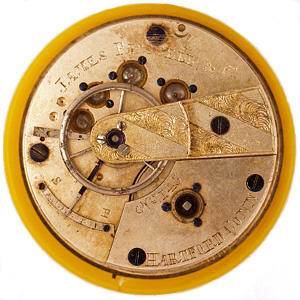
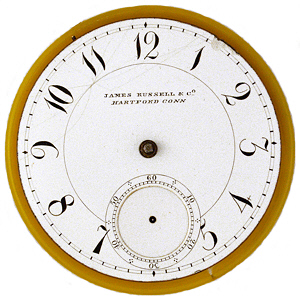
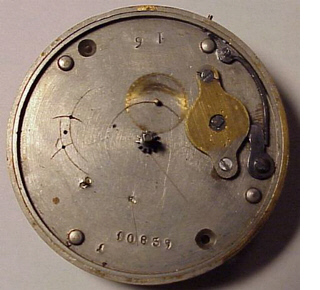

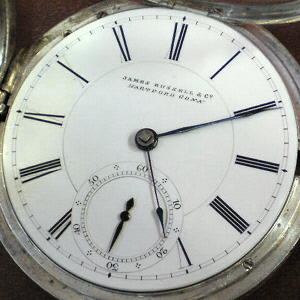
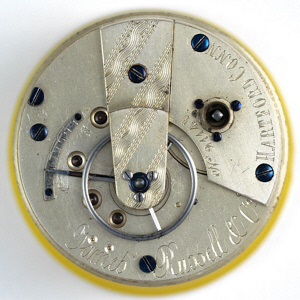
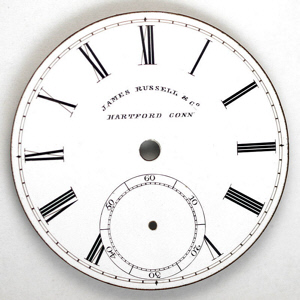
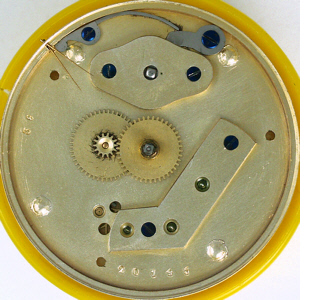
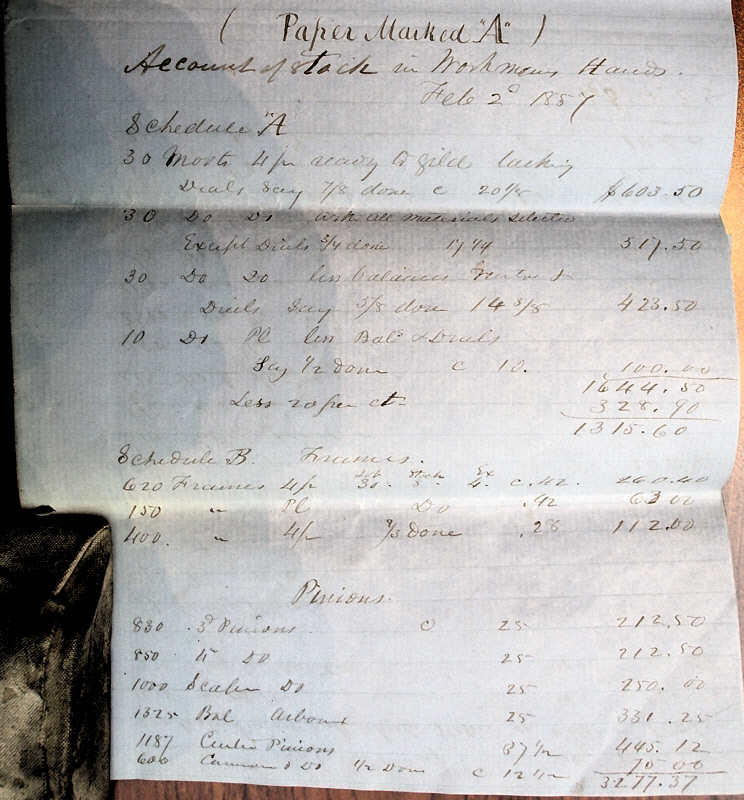
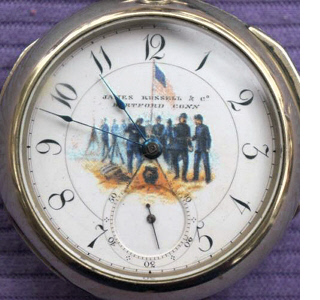
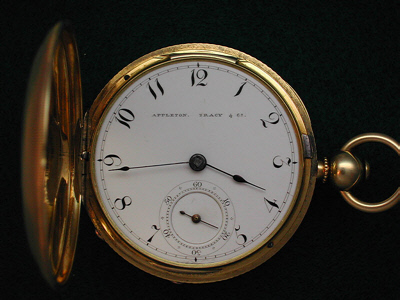
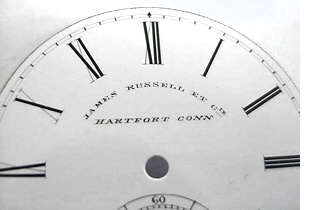
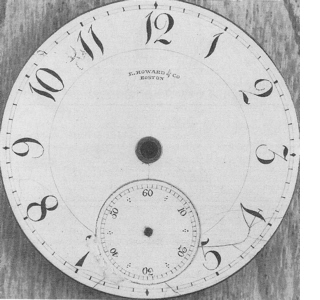
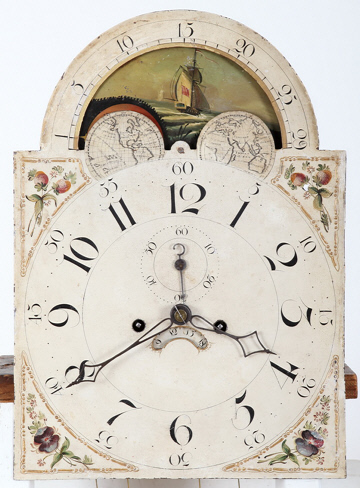
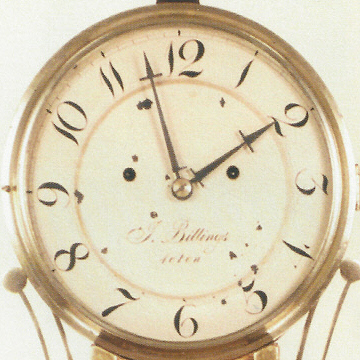
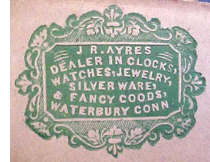 According to "Waterbury Thoughts" (a bog at http://waterburythoughts.blogspot.com) and to American Silversmiths (AmericanSilversmiths.org), a James Russell Ayres worked circa 1849-1872 as a jeweler and watchmaker in Waterbury CT. He was perhaps the most successful of Waterbury's early jewelry store owners. He advertised various watches and repairing in the Waterbury American newspaper, but not a specific watch named James Russell. His envelope cameo from the American Silversmiths website is shown here.
According to "Waterbury Thoughts" (a bog at http://waterburythoughts.blogspot.com) and to American Silversmiths (AmericanSilversmiths.org), a James Russell Ayres worked circa 1849-1872 as a jeweler and watchmaker in Waterbury CT. He was perhaps the most successful of Waterbury's early jewelry store owners. He advertised various watches and repairing in the Waterbury American newspaper, but not a specific watch named James Russell. His envelope cameo from the American Silversmiths website is shown here.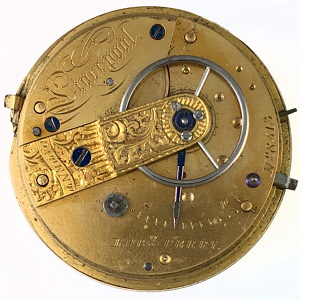
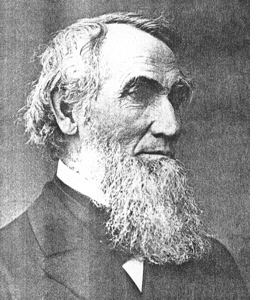 This Connection is a reverie for me because I see Dennison as an entrepreneur and visionary, a leader. But apparently he was not a good technician and mechanic, and many historians beat him up for this, which I think is undeserving.
This Connection is a reverie for me because I see Dennison as an entrepreneur and visionary, a leader. But apparently he was not a good technician and mechanic, and many historians beat him up for this, which I think is undeserving.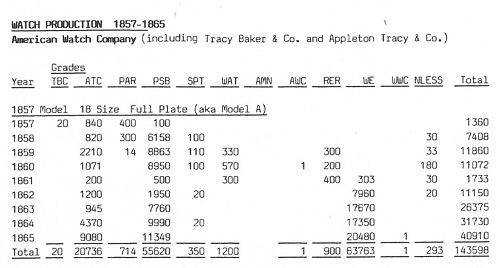
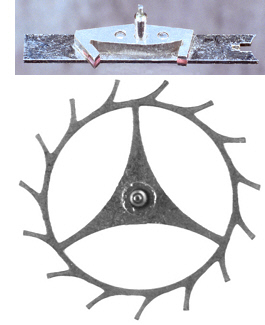 From the beginning of researching the JR watch, I have been reporting how similar the JR movement plates and related parts are to the Waltham Model 57, actually mostly identical or near identical. The internal parts are more difficult to examine, and I have not said much about them.
From the beginning of researching the JR watch, I have been reporting how similar the JR movement plates and related parts are to the Waltham Model 57, actually mostly identical or near identical. The internal parts are more difficult to examine, and I have not said much about them.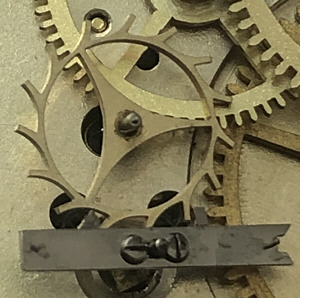
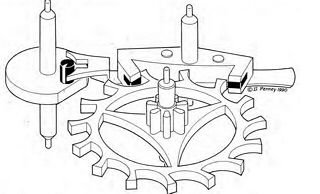
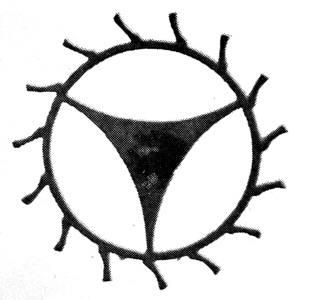
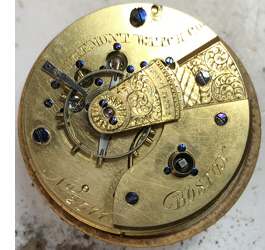
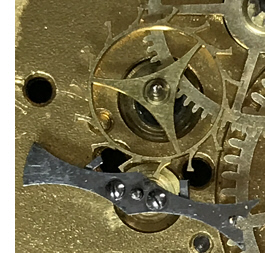
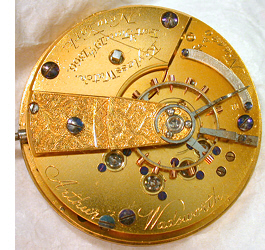
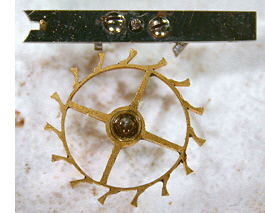

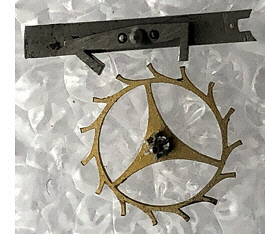 On the other hand, the AT fake is an excellent copy of Waltham with matching plates and dials that pretty much line up with JR. It also has sub-assembly numbers which indicate this is not one-of-a-kind. It has a blunt-end escapement (lever and wheel) that looks Waltham, as shown to the right. However, on closer view as shown below (click for larger view), the pinion and arbor on the escape wheels are different. The left wheel is JR 22899 (same for JR 20146); the right is the AT fake wheel.
On the other hand, the AT fake is an excellent copy of Waltham with matching plates and dials that pretty much line up with JR. It also has sub-assembly numbers which indicate this is not one-of-a-kind. It has a blunt-end escapement (lever and wheel) that looks Waltham, as shown to the right. However, on closer view as shown below (click for larger view), the pinion and arbor on the escape wheels are different. The left wheel is JR 22899 (same for JR 20146); the right is the AT fake wheel.